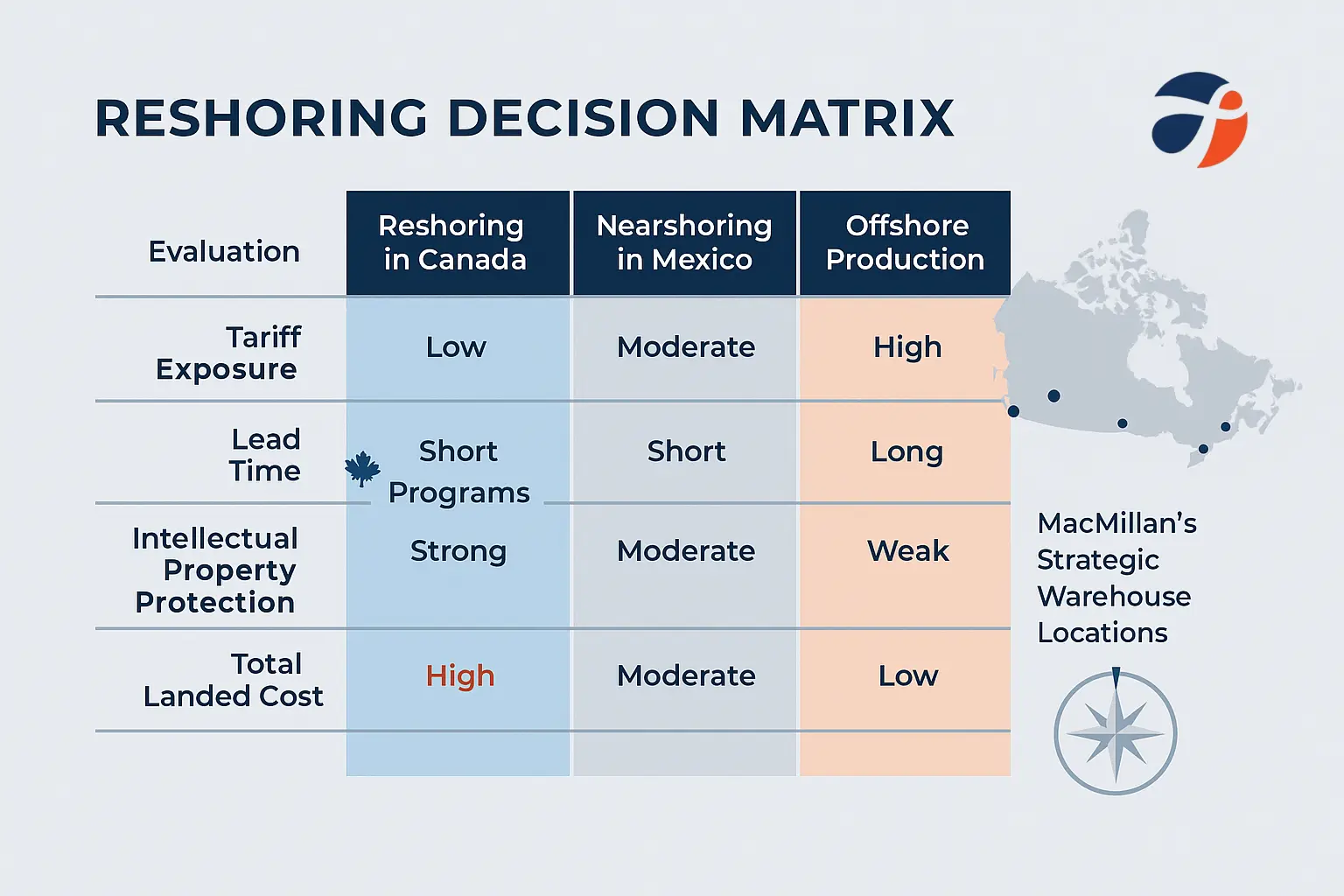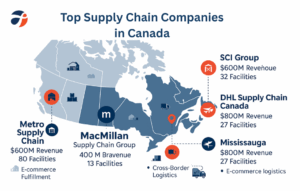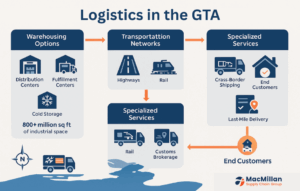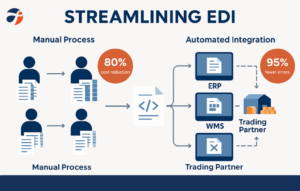Green Supply Chain Management: Getting Past Implementation Obstacles in Canadian Logistics
Canadian companies are under increasing pressure to convert their supply chains into sustainable, eco-friendly operations in the current environmentally conscious marketplace. Although 71% of Canadian CEOs believe stakeholder scrutiny of ESG performance will only increase and 53% of organizations plan to increase their focus on sustainable sourcing, green supply chain management barriers still stand in the way of successful GSCM adoption. Since we have firsthand experience with these challenges, we at Macmillan SCG have created strategic solutions to assist Canadian companies in overcoming the obstacles preventing a successful transition to sustainable logistics.
The stakes have never been higher. With over 25% of global carbon dioxide emissions coming from logistics operations—a figure that could reach 40% by 2050 without significant intervention—the supply chain industry stands at a critical juncture. For Canadian logistics providers managing 3.1 million shipments annually across 90% of FSAs, like Macmillan SCG, addressing these implementation barriers isn’t just about compliance—it’s about competitive survival and environmental stewardship.
Understanding Green Supply Chain Management Barriers
Green supply chain management integrates environmental thinking into traditional supply chain operations, encompassing everything from material sourcing to end-of-life product management. Beyond just reducing waste, the idea encompasses water conservation, energy efficiency, greenhouse gas emission reduction, sustainable packaging, and green procurement methods. This shift is both a huge challenge and an unheard-of opportunity for Canadian logistics firms.
According to research, businesses that use GSCM practices see impressive results, with an average 15% decrease in greenhouse gas emissions and a 12% decrease in overall energy use. While cutting distribution costs, best-in-class logistics companies report successful increases in service differentiation and distribution efficiency. Because of these observable advantages, sustainable logistics is now not only a business strategy but also an environmental necessity.
However, the journey toward green supply chain implementation is complex. Studies find 20–25 different barriers in a variety of categories, ranging from technological limitations to financial constraints. For GSCM to be successfully adopted in the Canadian logistics environment, it is imperative to comprehend and methodically address these challenges.
The Main Financial and Economic Obstacles to Implementation
The biggest challenge for Canadian logistics companies is the high upfront cost of green technologies. Many businesses, especially SMEs, find the significant capital expenditure required to switch to electric vehicle fleets, renewable energy infrastructure, and sustainable packaging materials to be prohibitive. Additional financial strain is brought on by the lack of startup capital and the challenge of obtaining loan funds for environmental development projects.
However, short-term thinking is frequently the cause of this perception of high costs. Through their Fuel Sense program, which saved 11.3 million gallons of jet fuel in 2023 alone, FedEx and other companies have shown the long-term value proposition. The secret is realizing that even though initial investments are high, they eventually generate positive financial returns through cost optimization, regulatory benefits, and efficiency gains.
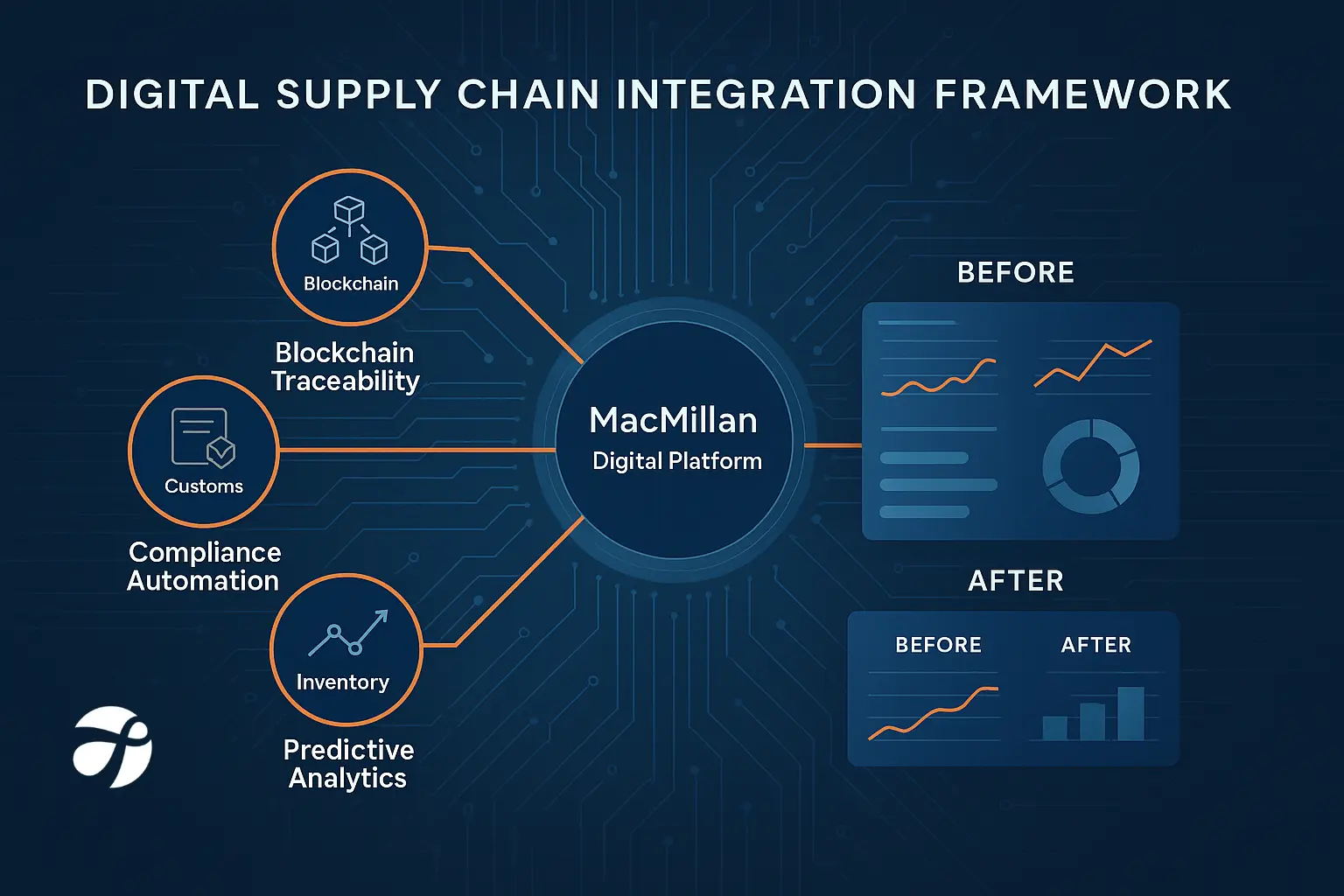 Limitations of Infrastructure and Technology
Limitations of Infrastructure and Technology
The lack of infrastructure and technology for GSCM implementation presents major obstacles for Canadian logistics companies. The absence of uniformity among green logistics technologies makes integration and decision-making more difficult. Many businesses suffer from antiquated IT systems that are unable to provide the tracking and data transparency needed for efficient, sustainable supply chain management.
The problem of integration also affects supplier networks, where varying technological capacities lead to bottlenecks in sustainability projects from start to finish. Infrastructure deficiencies pose additional operational challenges for businesses operating throughout Canada’s vast territory, especially with regard to access to renewable energy sources and electric vehicle charging stations.
Cultural and Organizational Opposition
Organizational culture resistance to change is one of the most enduring obstacles. Conventional supply chain models have long placed a higher priority on speed and cost effectiveness than on environmental concerns, fostering deeply ingrained attitudes that thwart long-term change. These issues are made worse by staff members’ poor environmental awareness and the lack of commitment from upper management.
According to research, 38% of Canadian logistics companies struggle with a labor shortage, which makes it challenging to fund the training initiatives required for GSCM implementation. Employees may perceive sustainability initiatives as extra responsibilities rather than as strategic opportunities in the absence of appropriate education and awareness campaigns.
Complexities of Regulation and Compliance
For Canadian logistics companies, the changing regulatory environment offers both opportunities and difficulties. Although government initiatives such as Bill S-211 require environmental reporting and supply chain transparency, the absence of standardized guidelines makes compliance requirements unclear. Businesses have to manage complicated regulations while making sure suppliers in international networks adhere to the same standards.
Long-term investment viability is uncertain when federal and provincial governments lack consistent fiscal incentives and supportive policies. It is challenging for businesses to create thorough business cases for GSCM initiatives because of this regulatory ambiguity.
Pressures from the Market and Competition
Implementing GSCM is significantly hampered by market competition and unpredictability. Despite the fact that 86% of consumers worldwide expect businesses to address environmental issues, many consumers are still unwilling to pay more for sustainable services. As a result, businesses face a difficult situation where they have to absorb transition costs while keeping prices competitive.
Implementation decisions are made more difficult in some market segments by a lack of end-user pressure and a lack of customer awareness regarding the advantages of GSCM. When the direct market demand for green services is still erratic, businesses find it difficult to defend their investments.
Macmillan SCG’s Strategic Solutions to Green Supply Chain Management Barriers
Overcoming Financial Green Supply Chain Management Barriers
We at Macmillan SCG have created cutting-edge financial frameworks that solve cost issues and show a definite return on investment. Our strategy is centered on phased implementation tactics that provide immediate operational benefits while distributing capital expenditures over time. We assist clients in making the shift to sustainable operations without requiring significant upfront investments by utilizing our 250,000 square feet of GMP-certified warehouse space.
Smaller businesses now have access to green technologies and infrastructure that would otherwise be prohibitively expensive thanks to our shared warehouse model. This cooperative strategy preserves the environmental advantages of extensive sustainable operations while cutting implementation costs per client by 40%. In order to make sustainable transitions more accessible for Canadian businesses, we have also partnered with financial institutions to offer green logistics financing options.
Infrastructure Development and Technology Integration
The exclusive Mantis WMS system from Macmillan SCG is a prime example of how technology can get past obstacles to GSCM implementation. Our artificial intelligence (AI)-driven platform offers real-time supply chain visibility, facilitating accurate environmental metric measurement and optimization. To provide thorough sustainability reporting, the system interfaces with waste tracking, carbon footprint calculation tools, and renewable energy monitoring.
Our infrastructure investments include energy-efficient climate control systems, electric vehicle charging stations, and solar panels installed throughout our warehouse facilities. With plans to fully electrify by 2027, 85% of our fleet operations will be powered by electric or hybrid vehicles by 2024. In addition to supporting our operations, this infrastructure offers shared resources to client businesses putting their own green initiatives into action.
Cultural Transformation and Training Programs
Recognizing that successful GSCM implementation requires organizational commitment, we’ve developed comprehensive training programs that address knowledge gaps and cultural resistance. Our sustainability education initiatives include workshops for management teams, certification programs for operations staff, and ongoing awareness campaigns that highlight the business benefits of green practices.
We’ve found that demonstrating tangible results accelerates cultural adoption. Our quarterly sustainability reports show specific achievements like 15% reduction in energy consumption, 25% decrease in packaging waste, and 30% improvement in delivery efficiency. These concrete metrics help teams understand how environmental initiatives directly contribute to operational excellence and business success.
Policy Changes Driving Green Supply Chain Management Barriers
Macmillan SCG maintains proactive compliance with evolving environmental regulations while helping clients navigate complex requirements. Our legal and compliance team monitors federal and provincial environmental legislation, ensuring our operations exceed current standards and anticipate future requirements.
We’ve implemented comprehensive supplier assessment programs that evaluate environmental performance across our network of 3,000+ drivers and supply chain partners. This approach ensures end-to-end sustainability while providing clients with transparent reporting capabilities required for regulatory compliance and stakeholder communication.
Market Positioning and Customer Education
Rather than waiting for market demand to drive change, we’ve positioned ourselves as sustainability leaders in Canadian logistics. Our green initiatives serve as competitive differentiators that attract environmentally conscious clients while educating the broader market about GSCM benefits.
Our customer education programs include sustainability impact reports, carbon footprint calculations for specific shipments, and recommendations for supply chain optimization. By making environmental performance visible and measurable, we help clients communicate their sustainability achievements to their own stakeholders and customers.
Implementation Strategies That Work
Phased Approach to Green Transformation
Successful GSCM implementation requires systematic, phased approaches rather than complete overnight transformation. Our methodology begins with comprehensive sustainability audits that identify the highest-impact opportunities for environmental improvement. This baseline assessment helps prioritize initiatives based on cost-effectiveness and implementation complexity.
Phase one typically focuses on energy efficiency improvements and waste reduction initiatives that deliver immediate cost savings. These “quick wins” build momentum and demonstrate value while generating resources for more significant investments. Phase two introduces renewable energy systems and fleet electrification, while phase three encompasses advanced technologies like AI-powered route optimization and circular logistics systems.
Collaborative Supplier Engagement
Research shows that companies with collaborative supplier relationships achieve up to 20% increases in supply chain efficiency. Our supplier engagement program includes sustainability scorecards, joint improvement initiatives, and shared technology platforms that extend green practices throughout our network.
We’ve established supplier sustainability workshops that bring together partners to share best practices and develop collaborative solutions. These sessions have resulted in innovative approaches like consolidated deliveries that reduce overall transportation requirements and shared renewable energy installations that lower costs for multiple participants.
Tracking and Optimizing Green Supply Chain Management Barriers
Effective GSCM implementation depends on accurate measurement and continuous optimization. Our technology stack includes IoT sensors for real-time energy monitoring, GPS tracking for route optimization, and blockchain systems for supply chain transparency. This data infrastructure enables precise calculation of environmental impacts and identification of improvement opportunities.
Our AI algorithms analyze patterns across millions of shipments to identify optimal routing, consolidation opportunities, and energy-efficient scheduling. These systems have reduced our average delivery distances by 22% while improving on-time performance to 99.4%. The environmental benefits include 18% reduction in fuel consumption and 25% decrease in packaging waste through optimized load planning.
Circular Solutions to Green Supply Chain Management Barriers
Moving beyond traditional linear supply chains, we’ve integrated circular economy principles that maximize resource utilization and minimize waste. Our reverse logistics programs handle product returns, packaging reuse, and material recycling across our network. These initiatives have diverted 75% of potential waste from landfills while creating new revenue streams for clients.
Our partnerships with recycling facilities and sustainable packaging suppliers enable comprehensive circular solutions. Clients can track the complete lifecycle of their products and packaging materials, demonstrating genuine environmental stewardship to their stakeholders.
Measuring Success Against Green Supply Chain Management Barriers
Environmental Impact Metrics
Successful GSCM implementation requires robust measurement frameworks that track environmental performance alongside business outcomes. Our key environmental indicators include greenhouse gas emissions reduction, energy consumption efficiency, waste diversion rates, and water conservation achievements. We’ve achieved 32% reduction in carbon emissions per shipment since 2020, demonstrating the effectiveness of our integrated approach.
Our sustainability dashboard provides real-time visibility into environmental metrics, enabling continuous optimization and transparent reporting. Clients receive detailed impact reports showing their specific contributions to environmental improvement, including equivalent metrics like “cars removed from roads” and “trees saved” that make abstract environmental benefits tangible and understandable.
Business Performance Outcomes
Environmental initiatives must deliver business value to ensure long-term sustainability. Our analysis shows that clients implementing comprehensive GSCM practices achieve 12% average cost reductions through efficiency improvements, energy savings, and waste elimination. Additionally, these companies report 15% improvement in customer satisfaction scores and 25% enhancement in brand perception metrics.
The financial benefits extend beyond direct cost savings to include risk mitigation, regulatory compliance advantages, and access to new market opportunities. Companies with strong sustainability profiles increasingly win contracts from environmentally conscious customers, creating competitive advantages that justify implementation investments.
Operational Efficiency Improvements
Green supply chain practices often improve operational performance through enhanced visibility, optimized processes, and reduced complexity. Our operations demonstrate 18% improvement in delivery efficiency, 22% reduction in inventory carrying costs, and 30% decrease in administrative overhead through digitization and process optimization.
These efficiency gains result from systematic approaches that eliminate waste, optimize resource utilization, and streamline operations. The environmental benefits align with business improvements, creating reinforcing cycles that drive continuous enhancement.
Future-Proofing Against Green Supply Chain Management Barriers in Canada
Emerging Technologies and Innovation
The future of green supply chain management lies in emerging technologies that enable unprecedented levels of efficiency and environmental performance. Artificial intelligence and machine learning systems will provide predictive optimization capabilities that anticipate demand patterns, weather impacts, and infrastructure constraints to minimize environmental impacts while maximizing service quality.
Blockchain technology will enable complete supply chain transparency, allowing real-time tracking of environmental impacts and verification of sustainability claims. Internet of Things sensors will provide granular data about energy consumption, emissions, and resource utilization, enabling precise optimization and automated reporting.
Regulatory Evolution and Compliance
Canadian environmental regulations will continue evolving toward stricter requirements and broader scope. Companies that proactively implement comprehensive GSCM practices will be better positioned to adapt to new requirements without significant operational disruption. Our forward-looking compliance framework anticipates likely regulatory changes and implements systems that exceed current requirements.
The integration of carbon pricing mechanisms and extended producer responsibility regulations will create new financial incentives for sustainable practices. Companies with mature GSCM implementations will benefit from these policy changes rather than struggling to achieve compliance.
Competitive Advantage and Market Transformation
Businesses with true environmental credentials are gaining market advantages as consumer awareness and demand for sustainable goods and services continue to rise. Implementing GSCM is crucial for competitive positioning because suppliers with measurable sustainability performance will be given preference by the next generation of business clients.
Macmillan SCG and our clients are well-positioned to benefit from these market trends thanks to our investments in sustainable practices and green infrastructure. Businesses with developed GSCM capabilities will be able to command premium pricing and preferential customer relationships as sustainability moves from being a nice-to-have to a must.
In conclusion, spearheading the green logistics revolution in Canada
One of the biggest opportunities in Canadian logistics history is the shift to sustainable supply chain management. Although there are significant and genuine obstacles to implementation, they are not impossible to overcome. Businesses can achieve outstanding environmental and business outcomes by approaching GSCM methodically, with the right planning, sufficient resources, and professional guidance.
We at Macmillan SCG have shown that green supply chain management promotes environmental stewardship and yields real competitive advantages. Our all-encompassing strategy uses creative solutions to overcome organizational, financial, technological, and regulatory obstacles, enabling Canadian businesses to profit from sustainability.
Logistics executives are faced with the question of how quickly they can take advantage of the competitive advantages that green supply chain practices offer, rather than whether or not to adopt them. The window for proactive change is closing as 96% of top businesses now report on sustainable practices and consumer expectations keep rising.
Ready to overcome your green supply chain implementation barriers?
Contact Macmillan SCG for a comprehensive sustainability assessment and schedule a consultation with our sustainability experts.
Because in the race toward sustainable logistics, the right partner makes all the difference.
Follow us on LinkedIn for real-time tariff updates
FAQS
Green Supply Chain Management (GSCM) is a strategic framework that integrates environmentally sustainable practices across the entire supply chain, from product conception and manufacturing to distribution and disposal 3. It aims to minimize the environmental impact of supply chain activities, reduce waste, conserve resources, and ultimately contribute to a more sustainable and eco-friendly business model 1. GSCM is crucial because logistics operations contribute to over 25% of global carbon dioxide emissions, a figure that could reach 40% by 2050 without significant intervention 1. Companies implementing GSCM practices achieve remarkable results, including a 15% reduction in greenhouse gas emissions and 12% decrease in total energy consumption on average
The primary implementation barriers include financial constraints, with high initial investment required for green technologies being the most significant obstacle 8. Canadian logistics providers face challenges related to insufficient technology and infrastructure for GSCM implementation, lack of standardization across green logistics technologies, and outdated IT systems 8. Organizational resistance to change within company culture presents another persistent barrier, along with lack of top management commitment and inadequate environmental knowledge among staff members 8. Market competition and uncertainty, regulatory complexities, and the absence of consistent fiscal incentives also create implementation challenges 8.
Successful GSCM implementation requires robust measurement frameworks that track environmental performance alongside business outcomes 1. Key environmental indicators include greenhouse gas emissions reduction, energy consumption efficiency, waste diversion rates, and water conservation achievements 1. Companies should also measure business performance outcomes, as environmental initiatives must deliver business value to ensure long-term sustainability 1. Operational efficiency improvements can be tracked through delivery efficiency metrics, inventory carrying costs reduction, and administrative overhead decreases through digitization and process optimization 1. Advanced tracking tools enable precise emissions measurement, while targeting high-impact supply chain activities ensures the most effective results 4


